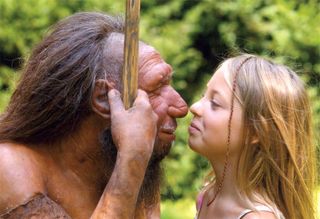Neanderthals Died Out Earlier Than Thought

Neanderthals may have died out earlier than before thought, researchers say.
These findings hint that Neanderthals did not coexist with modern humans as long as previously suggested, investigators added.
Modern humans once shared the planet with now-departed human lineages, including the Neanderthals, our closest known extinct relatives. However, there has been heated debate over just how much time and interaction, or interbreeding, Neanderthals had with modern humans.
To help solve the mystery, an international team of researchers investigated 215 bones previously excavated from 11 sites in southern Iberia, in an area known as Spain today. Neanderthals entered Europe before modern humans did, and prior research had suggested the last of the Neanderthals held out in southern Iberia until about 35,000 years ago, potentially sharing the region with modern humans for thousands of years.
Their data suggest that modern humans and Neanderthals may have actually lived in the area at completely different times, never crossing paths there at all. Even so, these findings do not call into question whether modern humans and Neanderthals once had sex — the findings simply indicate this interbreeding must have occurred earlier, before modern humans entered Europe.
"The genetic evidence for interbreeding — 1 to 4 percent Neanderthal DNA in present-day modern humans — suggests that interbreeding probably occurred before the period we are looking at in the Levant, the region around Israel and Syria, when modern humans first migrated out of Africa," researcher Rachel Wood, an archaeologist and radiocarbon specialist at Australian National University in Canberra, told LiveScience.
Dating bones
Sign up for the Live Science daily newsletter now
Get the world’s most fascinating discoveries delivered straight to your inbox.
Scientists discover the ages of artifacts and fossils using a variety of techniques. For instance, radiocarbon dating determines the age of biological remains based on the ratio between the carbon isotopes (atoms of the same element with different numbers of neutrons) carbon-12 and carbon-14 it holds — this proportion changes as radioactive carbon-14 breaks down while stable carbon-12 does not. Researchers can also look at the layers of soil and rock in which objects are found — if these layers were not disturbed over the years, then objects in the same layer should be the same age.
The investigators concentrated on collagen, the part of bone most suited for radiocarbon dating. Only eight of these bones from two sites in Spain — Zafarraya Cave and Jarama VI — had enough collagen for analysis. [Image Gallery: Our Closest Human Ancestor]
One bone, which came from a wild goat, was found in Zafarraya Cave in a similar layer as Neanderthal fossils. The bone was previously estimated as 33,300 years in age. However, using an ultrafiltration technique that cleansed the bone of modern carbon impurities that can give inaccurate younger dates, they found the bone was more than 46,700 years old.
"Our work suggests that at present, it is unlikely that Neanderthals survived any later in this area than they did elsewhere in mainland Europe," said researcher Thomas Higham at the University of Oxford in England.
The most surprising thing "was the enormous difference that the ultrafiltration dating made to the chronologies of the sites we looked at," Wood said. "At other sites in Europe, we have seen that this improved method of dating bone makes a difference, making old bones older. However, we do not normally see such consistently large differences. This is probably because the preservation of the organic materials — bone and charcoal — that are normally radiocarbon dated is really poor in warm climates like southern Spain."
Analysis of the remaining samples revealed they were at least 10,000 years older than previously estimated. Instead, they were close to or more than 50,000 years old, the upper limit for radiocarbon dating.
When Neanderthals died out
"Our results cast doubt on a hypothesis that has been broadly accepted since the early 1990s — that the last place for surviving Neanderthals was in the southern Iberian Peninsula," Wood said. "Much of the evidence that has supported this idea is based on a series of radiocarbon dates, which cluster at around 35,000 years ago. Our results call all of these results into question."
These findings suggest modern humans and Neanderthals might not have interacted in this area. In northern Iberia, about 150 miles (250 kilometers) north of Jarama VI, past research suggested modern humans were only present starting about 42,000 years ago. These new findings hint that modern humans and Neanderthals did not coexist for millennia as before thought, and did not live side-by-side. [10 Mysteries of the First Humans]
"The results of our study suggest that there are major problems with the dating of the last Neanderthals in modern-day Spain," Higham said. "We now have to look very cautiously at the model of late Neanderthal survival in southern Iberia and focus our efforts on more rigorous dating programs."
One site, Cueva Antón in Spain, did seem as young as previously thought. However, it remains uncertain whether the artifacts there are linked with Neanderthals — they may belong to modern humans.
The researchers caution they are not definitely saying that there were no Neanderthals in southern Iberia after 42,000 years ago. "What we have is a gap where we have no reliable radiocarbon dates. There might have been Neanderthals or modern humans or both or neither," Wood said. Also, "there are several circumstances which could have obscured later interbreeding events in Europe, so it is not possible to say, for example, that at one time there was not more Neanderthal DNA in Europeans."
The scientists detailed their findings online Feb. 4 in the journal Proceedings of the National Academy of Sciences.
Follow LiveScience on Twitter @livescience. We're also on Facebook & Google+.

Most Popular


